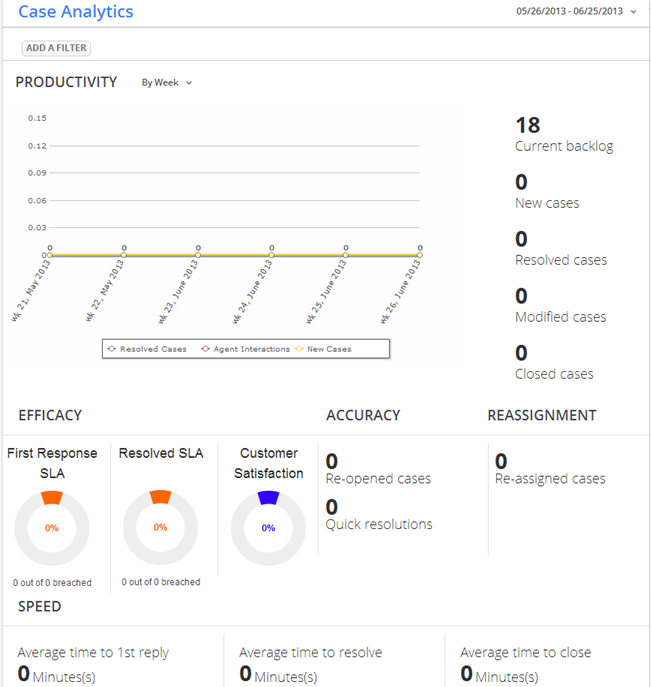Difference between revisions of "Case Analytics"
imported>Aeric |
imported>Aeric |
||
| Line 13: | Line 13: | ||
The Case Analytics dashboard displays data recorded in the Case Analytic object--a specialized object that records statistical data in the [[ServiceDesk]] application. In that object, one record is created for each agent, each day, for all cases at a given priority. (That strategy keeps data storage to a minimum, and speeds up reporting.) | The Case Analytics dashboard displays data recorded in the Case Analytic object--a specialized object that records statistical data in the [[ServiceDesk]] application. In that object, one record is created for each agent, each day, for all cases at a given priority. (That strategy keeps data storage to a minimum, and speeds up reporting.) | ||
The Case Analytics object can also be used for reporting. | The Case Analytics object can also be used for reporting. | ||
; | ;Fields: | ||
: '''Agent Interactions -''' a count of messages sent by an agent | |||
: '''Customer Interactions -''' a count of messages received from a customer | |||
:: When the "agent" is the portal user, agent interactions is always zero, and customer interactions is the total number of messages received from customers. | |||
: '''Satisfaction Rating -''' an aggregate value taken from all cases (for a given agent, on a given day, at a given priority) for which a survey was completed. | |||
:* '''Customer Satisfaction Case Record Count -''' the number of cases that have a customer_satisfaction rating for that day. Use it to calculate average for the day. | |||
: {{TBD|Is that sufficient?}} | |||
: '''Time to Resolve -''' The total time for all cases resolved that day, in that category. | |||
::{{TBD|In each record, right?}} | |||
:: Divide that value by '''Resolved Cases''' (a count) to get an average. | |||
;Considerations: | |||
:* Cases of type "Problem" and "Incident" are recorded. Other case types are not recorded. | :* Cases of type "Problem" and "Incident" are recorded. Other case types are not recorded. | ||
: | : | ||
| Line 30: | Line 40: | ||
: | : | ||
:* To convert a time to days, divide again by 24. | :* To convert a time to days, divide again by 24. | ||
<noinclude> | <noinclude> | ||
[[Category:Analytics]] | [[Category:Analytics]] | ||
</noinclude> | </noinclude> | ||
Revision as of 21:35, 30 January 2014
Case Analytics is a special feature of the ServiceDesk application. It consists of the Case Analytics dashboard, and the Case Analytics object. This article explains what you can do with them, and how they work.
Case Analytics Dashboard
The image below shows the initial dashboard displayed in the ServiceDesk application. In the table, aggregate number of cases is shown for each agent, each day, for each of the priority levels.
To modify the display:
- Click [Add a Filter]
- Choose the agent, priority, and date range to display.
The graph changes to show the selected data.
Case Analytics Object
The Case Analytics dashboard displays data recorded in the Case Analytic object--a specialized object that records statistical data in the ServiceDesk application. In that object, one record is created for each agent, each day, for all cases at a given priority. (That strategy keeps data storage to a minimum, and speeds up reporting.)
The Case Analytics object can also be used for reporting.
- Fields
- Agent Interactions - a count of messages sent by an agent
- Customer Interactions - a count of messages received from a customer
- When the "agent" is the portal user, agent interactions is always zero, and customer interactions is the total number of messages received from customers.
- Satisfaction Rating - an aggregate value taken from all cases (for a given agent, on a given day, at a given priority) for which a survey was completed.
- Customer Satisfaction Case Record Count - the number of cases that have a customer_satisfaction rating for that day. Use it to calculate average for the day.
- __TBD: Is that sufficient?__
- Time to Resolve - The total time for all cases resolved that day, in that category.
- __TBD: In each record, right?__
- Divide that value by Resolved Cases (a count) to get an average.
- Considerations
-
- Cases of type "Problem" and "Incident" are recorded. Other case types are not recorded.
-
- Customers who create cases directly are known collectively as the "Portal User" agent. That value can be used to filter out customer data from a report.
-
- You can filter data by agent, by date range, and by priority.
-
- Response and resolution times are stored in minutes. (The business calendar is not taken into account.)
-
- To convert a time in minutes to hours:
- Create or customize a Report.
- In the Fields tab, at the bottom of the page. click New Formula.
- Divide the time-field value by 60 to get a value in hours.
For example: time_to_closed / 60
-
- To convert a time to days, divide again by 24.
